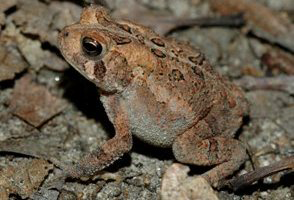During the breeding season, mature male toads often inadvertently bump into each other as they sing and swim in breeding sites. Sometimes one male will grasp another male, thinking the other toad might be a female. The male that was grabbed will usually chirp and vibrate, signaling to the other male that he has grabbed a male, not a female.
Photo Credit: Geoffrey A. Hammerson
Anaxyrus americanus
Common Name: American toad
Other Scientific Names: Bufo americanus
Animal Guild: Amphibian
Class > Order > Family: Amphibia > Anura > Bufonidae
What does the species look like?
Adults: Warty skin, generally with one to two warts in each of the largest dark spots on their back. Adults usually have dark spots on their chest and abdomen and large warts on their lower hind legs. They are between 5 and 10 cm long, usually around 7.5 cm (3.5 inches).
Mature males: Dark throat and dark pads on thumbs and inner fingers during breeding season.
Breeding call: Males make a long, musical trill lasting up to around 30 seconds.
Larvae: Tadpoles are blackish with no spots on their low tail fin; their small eyes are on the tops of their head. They can reach a total length of up to about 24 mm (0.9 inches).
Eggs: American toads lay eggs in long strings that can become tangled in vegetation.
Where is the species found?
States & Provinces
AL, AR, CT, DC, DE, GA, IA, IL, IN, KS, KY, LA, MA, MB, MD, ME, MI, MN, MO, MS, NB, NC, ND, NE, NH, NJ, NL, NS, NY, OH, OK, ON, PA, PE, QC, RI, SC, SD, TN, TX, VA, VT, WI, WV
Distribution
The range of American toads extends from Labrador, the Hudson Bay area, and central Manitoba south to northern Texas, Louisiana, central Alabama, northern Georgia, and North Carolina. This species is absent from most of the Coastal Plain.
American toads live on land except during the brief breeding season. They live in a wide variety of habitats, ranging from forests to prairies, wherever there is sufficient moisture, food, and a suitable water body where they can breed.
General Phenology and Life History
American toads are dormant during the winter. When they emerge, they migrate (sometimes several hundred meters or yards) from their land-based habitat to water bodies where they breed. They breed in spring (or winter in the south) in shallow areas in slow or nonflowing bodies of water, including both temporary and permanent pools with few, if any, fishes. Hundreds of adults may come together when they breed. Larvae metamorphose into tiny toadlets within a couple of months.
Which phenophases should I observe?
Do you see/hear...?
Activity
Adults on land More...
For abundance, enter the number of individual animals observed in this phenophase.
Adults in water More...
For abundance, enter the number of individual animals observed in this phenophase.
Adults feeding For abundance, enter the number of individual animals observed in this phenophase.
Reproduction
Vocalizing What is the intensity of vocalizing?
Single calls: There is space between calls and individuals can be counted. Overlapping calls: Calls of individuals can be distinguished but there is some overlapping of calls. Full chorus: Calls are constant and overlapping.
Mating For abundance, enter the number of individual animals observed in this phenophase.
Fresh eggs For abundance, enter the number of individual animals observed in this phenophase.
Development
Dead adults For abundance, enter the number of individual animals observed in this phenophase.
What do these phenophases look like?
There is currently no photoguide available for this species. If you'd like help us create one, use the guidance document and species template provided here . Then send it via email to education@usanpn.org when it is complete.
